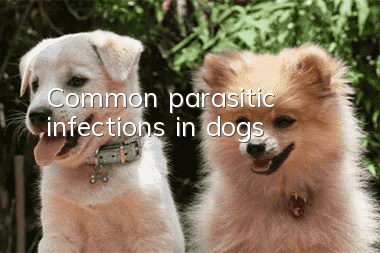Common parasitic infections in dogs

Parasitic diseases are common diseases in dogs, which have a very bad impact on the dog's life. In severe cases, it can even cause the dog's death. Parasitic diseases have a certain incubation period. Clinical symptoms are rarely seen in the early stages of the disease and are often ignored by dog parents.
What are the common parasitic diseases in dogs:
Canine ascariasis:
Roundworms live in the small intestine and stomach of dogs. After infection, dogs gradually lose weight, lose appetite, vomit, and first have diarrhea and then constipation. It mainly harms puppies between 1 and 3 months old, affecting their growth and development. Severe infection can lead to death.
When a small amount of roundworms migrate into the lungs, dogs may develop fever, chills, cough, difficulty breathing, asthma, bloody sputum, and loss of appetite;
A large number of roundworms in the intestine will cause varying degrees of digestive tract symptoms, such as polyphagia or anorexia, nausea, vomiting, and diarrhea
Canine hookworm disease:
Hookworms live in the small intestine. When severely infected, they lose weight and have thick, dull coats that fall off easily. Loss of appetite, heterophilia, vomiting, bloody or black feces with a putrid smell. Can cause severe anemia, leading to coma and death.
The sick dog has loose stools with blood and mucus, anemia, weight loss and loss of appetite;
Sometimes there is swelling, growth and development disorders, and sometimes itching.
Canine whipworm:
This disease is caused by Trichocephalus vulgaris parasitizing the cecum of dogs. Generally, the infection does not show clinical symptoms. In severe cases, the head of the parasite penetrates deeply into the mucosa, which can cause acute or chronic enteritis. Blood-sucking worms often cause anemia in sick dogs.
Generally, infections do not show clinical symptoms;
In severe infection, acute or chronic enteritis can be caused because the head of the parasite burrows deeply into the mucous membrane;
Canine heartworm disease:
Heartworms parasitize the right ventricle and pulmonary artery of dogs, causing symptoms such as circulatory disorders, dyspnea, and anemia. Dogs that have been infected for a long time have obvious pulmonary heart disease. In the final stage, they may die due to systemic weakness or collapse during exercise.
Initial stage: Lack of energy, loss of appetite, persistent dry cough
Mid-term: weight loss, fatigue, and deterioration in exercise tolerance
Canine Taeniasis:
Tapeworms parasitize the small intestine of dogs. Mild infections usually go unnoticed. Severe infections may cause abnormal appetite (bulimia, heterophilia), vomiting, chronic enteritis, alternating diarrhea and constipation, and anemia.Weight loss, easily agitated or depressed, and some may suffer from convulsions or paralysis of limbs.
When the worms form into clumps, they can block the intestines, leading to acute abdominal diseases such as intestinal obstruction, intussusception, volvulus, and intestinal rupture.
In the early stages of tapeworm infection, most dogs do not show symptoms. In severe infection, symptoms of enteritis, hemorrhagic enteritis, and vomiting may occur.
When the intestinal peristalsis occurs, the worms can enter the stomach. During vomiting, the worms can be vomited out together with the stomach contents.
Toxoplasma gondii
Generally, the symptoms of dogs infected with toxoplasmosis are not obvious, and the owner cannot tell the difference through observation and must go to the hospital to pass a test strip test. Only when the infection is severe, dogs will have fever, cough, weakness, eye and nose secretions, anorexia, and even hemorrhagic diarrhea, vomiting, paralysis. Pregnant dogs may suffer from premature birth or miscarriage, and canine distemper and contagious diseases Hepatitis symptoms are similar.
Toxoplasma gondii is a single-cell intracellular parasite that travels with the blood and reaches various parts of the body.
It is almost the most successful single-celled animal on earth and is ubiquitous all over the world
Tick
The tick adheres to the dog's body and extends its mouthparts into the skin to suck blood. Alcohol can be applied to the tick's body to relax the tick's head or cause it to die. After a few minutes, use sharp-tipped tweezers and pull sharply in a vertical direction to remove the tick.
After a tick bites, it will emit an anesthesia. The dog will not feel pain when it stings or sucks blood, but it may cause local congestion and edema
Tick bites must be removed promptly, otherwise it will cause high fever, headache, fatigue, and muscle aches
Fleas
When a dog is bitten by a flea, it looks like there are small red pimples, and there is a black gritty substance in the fur. In some more sensitive dogs, flea saliva can cause extensive inflammation on the dog's back. It can also spread other diseases.
Scratching, rubbing and biting the coat, causing hair loss, hair breakage and abrasions;
In severe cases, fluid may leak out from the skin abrasion, and even suppurative wounds may form;
Lice
When lice bite a dog, the saliva they secrete enters the dog's skin, causing itching. Scratching can damage the skin, leading to secondary infection and the formation of abscesses. It can also spread a variety of diseases when sucking blood.
Itching: Itching is the main symptom, but the degree varies among individuals. Infection often occurs due to scratching, and pustules ooze after rupture
Bugs or eggs: Small bugs can be found at the roots of hair follicles, which are light black, gray-white or red (suck blood).
Mites
There are two types of mites that dogs are susceptible to: scabies and demodex. Scabies mites live in the dog's skin and bite, move, chew and pierce the skin, causing severe itching, oozing, desquamation, thickening and irritation of the affected area. Symptoms such as hair loss.
Canine Demodex mostly parasitizes in the hair follicles of the dog's eyes, ears, lips, and the hairless areas on the inside of the front legs. In severe cases, the mites can parasitize in the dog's lymph nodes and other tissues, and even in the dog's ear canals and toes ( Insects can also be found between fingers, and systemic Demodex infection often occurs due to decreased immune function.
Eyeworm
Eye worms are a type of nematode that live in the tear duct, nictitating membrane or conjunctival sac. They are spread by flies licking and sucking the eyes of animals with worms, and then licking and sucking other animals or people. Eye worms damage the conjunctiva and conjunctiva of dogs. The cornea causes conjunctivitis and keratitis and stimulates tear secretion. It is more serious when secondary bacterial infection occurs.
Initial stage: Symptoms such as eye flushing, tearing, and corneal opacity.
Mid-term: When the inflammatory process intensifies, purulent secretions flow out of the eyes, often causing the upper and lower eyelids to stick together.
- Symptoms and treatments for long bone spurs in dogs’ lumbar vertebrae
- French Bulldog Characteristics
- What are the most taboo foods for Scottish Shepherds?
- Why do puppies scratch the floor?
- Can dogs eat boiled peanuts?
- What are the causes of bad breath in dogs?
- How to raise a newly weaned puppy
- Why don’t dogs like having their paws touched?
- Why is the dog vomiting white foam?
- How to train Shiba Inu puppies? Daily training methods for Shiba Inu puppies!



